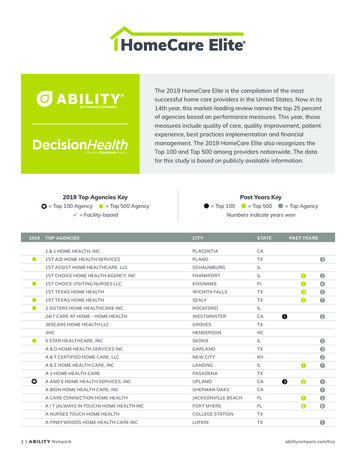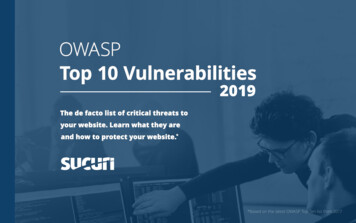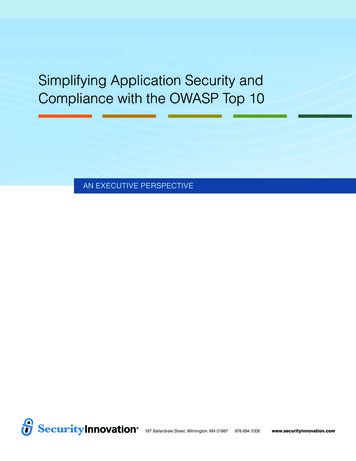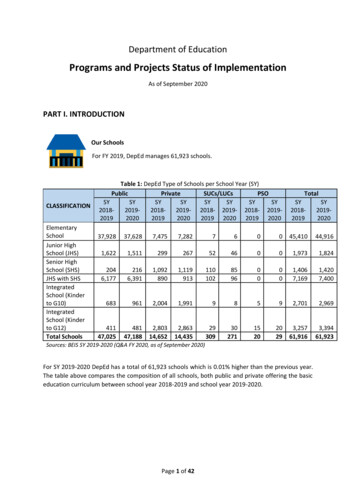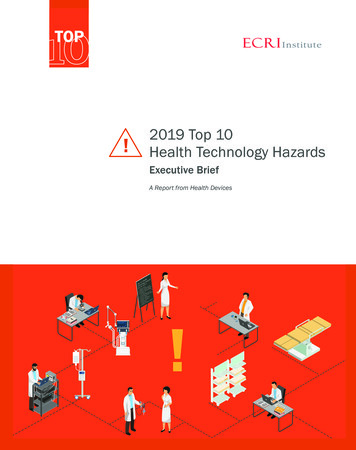
Transcription
TOP!2019 Top 10Health Technology HazardsExecutive BriefA Report from Health Devicesshalt rdHe aza10 gy HTop hnolo 019nTec for 2 rity inatio gesm pon stcutalis erse Con al S tionicCyb ess urg nec1. attr ed S isconMDing g2. etain torcess insRla3. enti larm epro ammR rogrVdA e4.an oscop p P sumsdEn sion P larm tem.A Sys l5 fuorIn6. onit t Lift ctricasMnletem7. atie g ESysPin8. lean ents gingon arC9. omp ChC teryBat10.!
!2019 TopTop10102019HealthHealth TechnologyTechnologyHazardsHazardsExecutive BriefExecutiveBriefA Report from Health DevicesECRI Institute is providing this abridged version of its 2019 Top 10 list of health technologyhazards as a free public service to inform healthcare facilities about important safety issuesinvolving the use of medical devices and systems. The full report—including detailed problemdescriptions and ECRI Institute’s step-by-step recommendations for addressing the hazards—is available to members of ECRI Institute programs through their membership web pages.The List for 20191. Hackers Can Exploit Remote Access to Systems, DisruptingHealthcare Operationsshalt rdHe aza10 gy HTop hnolo 019nTec for 2 rity inatio gesm pon stcutaSsli erse s Con ical ection2. “Clean” Mattresses Can Ooze Body Fluids onto PatientsCyb es urg n1. attr ed S isconMDing g2. etain torcess insRla3. enti larm epro ammR rogrVdA e4.an oscop p P sdPum rm msEn5. fusion Ala Syste lorIn6. onit t Lift ctricasM ien Eletem.7 atSysPing8. lean ents gingon arC9. omp ChC teryBat10.3. Retained Sponges Persist as a Surgical ComplicationDespite Manual Counts!4. Improperly Set Ventilator Alarms Put Patients at Risk forHypoxic Brain Injury or Death5. Mishandling Flexible Endoscopes after Disinfection CanLead to Patient Infections6. Confusing Dose Rate with Flow Rate Can Lead to InfusionPump Medication Errors7. Improper Customization of Physiologic Monitor AlarmSettings May Result in Missed Alarms8. Injury Risk from Overhead Patient Lift Systems9. Cleaning Fluid Seeping into Electrical Components CanLead to Equipment Damage and Fires10. Flawed Battery Charging Systems and Practices Can AffectDevice Operation 2018 ECRI Institute. 2019 Top 10 Health Technology Hazards: Executive BriefMembers can access the full report online. ECRI Institute encourages the dissemination of the registration hyperlink, www.ecri.org/2019hazards,to access a download of this Executive Brief, but prohibits the direct dissemination, posting, or republishing of this work, without prior permission.1
The Purpose of the ListThe safe use of health technology—from simple devices to complex information systems—requiresidentifying possible sources of danger or difficulty with those technologies and taking steps tominimize the likelihood that adverse events will occur. This list will help healthcare facilities do that.Produced each year by ECRI Institute’s Health Devices Group, the Top 10 Health TechnologyHazards list identifies the potential sources of danger that we believe warrant the greatestattention for the coming year. The list does not enumerate the most frequently reported problemsor the ones associated with the most severe consequences—although we do consider suchinformation in our analysis. Rather, the list reflects our judgment about which risks should receivepriority now.All the items on our list represent problems that can be avoided or risks that can be minimizedthrough the careful management of technologies. With the additional content provided in thefull report, the list serves as a tool that healthcare facilities can use to efficiently and effectivelymanage the risks.How Topics Are SelectedThis list focuses on what we call generic hazards—problems that result from the risks inherentto the use of certain types or combinations of medical technologies. It does not discuss risks orproblems that pertain to specific models or suppliers.ECRI Institute engineers, scientists, clinicians, and other patient safety analysts nominate topics forconsideration based on their own expertise and insight gained through: Investigating incidents Testing medical devices Observing operations and assessing hospital practices Reviewing the literature Speaking with clinicians, clinical engineers, technology managers, purchasing staff, healthsystems administrators, and device suppliersStaff also consider the thousands of health-technology-related problem reports that we receivethrough our Problem Reporting Network and through data that participating facilities share withour patient safety organization, ECRI Institute PSO.After the topic nomination phase, professionals from ECRI Institute’s many program areas, as wellas external advisors, review these topics and select their top 10. We use this feedback to producethe final list, weighing factors such as the following: 2018 ECRI Institute. 2019 Top 10 Health Technology Hazards: Executive Brief2Members can access the full report online. ECRI Institute encourages the dissemination of the registration hyperlink, www.ecri.org/2019hazards,to access a download of this Executive Brief, but prohibits the direct dissemination, posting, or republishing of this work, without prior permission.
Severity. What is the likelihood that the hazard could cause serious injury or death? Frequency. How likely is the hazard? Does it occur often? Breadth. If the hazard occurs, are the consequences likely to spread to affect a great numberof people, either within one facility or across many facilities? Insidiousness. Is the problem difficult to recognize? Could the problem lead to a cascade ofdownstream errors before it is identified or corrected? Profile. Is the hazard likely to receive significant publicity? Has it been reported in the media,and is an affected hospital likely to receive negative attention? Has the hazard become afocus of regulatory bodies or accrediting agencies? Preventability. Can actions be taken now to prevent the problem or at least minimize therisks? Would raising awareness of the hazard help reduce future occurrences?All the topics we select for the list must, to some degree, be preventable. But any one of the othercriteria can, on its own, warrant including a topic on the list. We encourage readers to examinethese same factors when judging the criticality of these and other hazards at their own facilities.Not all hazards on the list will apply at all healthcare facilities. Also note that the exclusion ofa topic that was included on a previous year’s list should not be interpreted to mean that thetopic no longer deserves attention. Most of these hazards persist, and hospitals should continueworking toward minimizing them. Rather, our experts determined that the topics listed hereshould receive greater attention in 2019.For Members Only: Log in to Access the Full Report and Solutions KitThis Executive Brief helps raise awareness of critical health technology hazards—a key stepin patient safety efforts. The next steps involve taking action to prevent the problems fromoccurring. The 2019 Top 10 Health Technology Hazards Solutions Kit—available online tomembers of ECRI Institute programs—will help with that effort.The Solutions Kit provides a comprehensive discussion of each topic, actionable recommendationsfor minimizing the risks of harm, and lists of useful resources for more information about eachtopic. Log in to your membership web page to access this valuable content.For information about becoming a member, contact clientservices@ecri.org orcall 1 (610) 825-6000, ext. 5891. 2018 ECRI Institute. 2019 Top 10 Health Technology Hazards: Executive BriefMembers can access the full report online. ECRI Institute encourages the dissemination of the registration hyperlink, www.ecri.org/2019hazards,to access a download of this Executive Brief, but prohibits the direct dissemination, posting, or republishing of this work, without prior permission.3
Hackers Can Exploit Remote Access toSystems, Disrupting Healthcare OperationsCybersecurity attacks that infiltrate a network by exploiting remote accessfunctionality on connected devices and systems—or by any other means—remain asignificant threat to healthcare operations. Attacks can render devices or systemsinoperative, degrade their performance, or expose or compromise the data they hold,all of which can severely hinder the delivery of patient care and put patients at risk.Remote access systems are a common target because they are, by nature, publiclyaccessible. Intended to meet legitimate business needs, such as allowing off-siteclinicians to access clinical data or vendors to troubleshoot systems installed at thefacility, remote access systems can be exploited for illegitimate purposes.Attackers take advantage of unmaintained and vulnerable remote access systems toinfiltrate an organization’s network. Once they gain access—whether through medicalor nonmedical assets—attackers can move to other connected devices or systems,installing ransomware or other malware, stealing data or rendering it unusable, orhijacking computing resources for other purposes, such as to generate cryptocurrency.Safeguarding assets requires identifying, protecting, and monitoring all remote accesspoints, as well as adhering to recommended cybersecurity practices, such as institutinga strong password policy, maintaining and patching systems, and logging systemaccess. 2018 ECRI Institute. 2019 Top 10 Health Technology Hazards: Executive Brief4Members can access the full report online. ECRI Institute encourages the dissemination of the registration hyperlink, www.ecri.org/2019hazards,to access a download of this Executive Brief, but prohibits the direct dissemination, posting, or republishing of this work, without prior permission.
“Clean” Mattresses Can OozeBody Fluids onto PatientsBlood and other body fluids that remain on, or within, mattresses or mattress coversafter cleaning can contact subsequent patients, posing an infection risk. Reportedincidents include patients lying on an apparently clean bed or stretcher when bloodfrom a previous patient oozed out of the surface onto the patient.Mattress covers are intended to prevent body fluids and other contaminants fromgetting into mattresses. If a cover is not cleaned and disinfected effectively, or if itsintegrity is compromised in a way that allows the mattress underneath to becomecontaminated, subsequent patients could be exposed to infectious materials.(Mattresses themselves are not cleaned and disinfected between patients.)Healthcare facilities must take care to use appropriate products and procedures forcleaning and disinfecting mattress covers, and they should regularly inspect mattressesand covers for signs of damage or contamination.One key challenge, however, is that not all mattress cover suppliers recommendproducts and procedures that will successfully remove the likely surface contaminantswithout compromising the cover’s integrity (i.e., creating weak spots that could allowleaks). This situation needs to be remedied. 2018 ECRI Institute. 2019 Top 10 Health Technology Hazards: Executive BriefMembers can access the full report online. ECRI Institute encourages the dissemination of the registration hyperlink, www.ecri.org/2019hazards,to access a download of this Executive Brief, but prohibits the direct dissemination, posting, or republishing of this work, without prior permission.5
Retained Sponges Persist as a SurgicalComplication Despite Manual CountsSurgical sponges that are unintentionally left inside the patient after the surgicalsite is closed can lead to infection and other serious complications, including the needfor secondary operations.Manual counts—in which the surgical team verifies that all sponges are accounted forbefore concluding the procedure—are standard practice, but they are prone to error. Ifsuch errors result in a retained sponge, complications can ensue, with consequencesfor both the patient and the healthcare facility.Accurate data on the incidence of retained surgical sponges is hard to come by; forone thing, incidents may not be identified unless (or until) the patient returns with acomplaint of pain or discomfort. Nevertheless, we know the problem persists. Availabledata suggests that every year thousands of U.S. patients could experience a retainedsurgical item (RSI), with surgical sponges being the most commonly retained item.Technologies that supplement the manual counting process are available and havebeen found to be effective when used correctly. ECRI Institute contends that broaderadoption of these technologies could further reduce the risk that a surgical sponge willbe unintentionally retained during a procedure. 2018 ECRI Institute. 2019 Top 10 Health Technology Hazards: Executive Brief6Members can access the full report online. ECRI Institute encourages the dissemination of the registration hyperlink, www.ecri.org/2019hazards,to access a download of this Executive Brief, but prohibits the direct dissemination, posting, or republishing of this work, without prior permission.
Improperly Set Ventilator AlarmsPut Patients at Risk forHypoxic Brain Injury or DeathMechanically ventilated patients are at risk if user-adjustable ventilator alarms arenot tailored to the patient’s respiratory parameters. Leaks, disconnections, and otherfailures associated with a ventilator’s consumable components are a fairly commonoccurrence and can quickly lead to harm if the condition is not identified and rectifiedpromptly.Ventilators are life-support devices that deliver positive-pressure breaths to patientswho require assistance to breathe adequately. These devices rely on consumablecomponents, such as plastic breathing circuits, to help convey respiratory gasesbetween the ventilator and the patient. Loose connections, manufacturing defects,or other problems with these components can prevent adequate ventilation. Withinminutes, inadequate ventilation can result in hypoxic brain injury or death.Properly set alarms can prevent such consequences. Yet ECRI Institute continues toinvestigate deaths resulting from breathing circuit disconnections during which noalarm activated. In two cases from early 2018, alarms to detect inadequate ventilation,such as the minute-volume and low-pressure alarms, were not set appropriately.Healthcare facilities need policies on setting user-adjustable ventilator alarms andprotocols for verifying that the policies are being followed and that componentconnections are secure. 2018 ECRI Institute. 2019 Top 10 Health Technology Hazards: Executive BriefMembers can access the full report online. ECRI Institute encourages the dissemination of the registration hyperlink, www.ecri.org/2019hazards,to access a download of this Executive Brief, but prohibits the direct dissemination, posting, or republishing of this work, without prior permission.7
Mishandling Flexible Endoscopes afterDisinfection Can Lead to Patient InfectionsCleaning and disinfecting flexible endoscopes between uses is known to be achallenging process. Failure to precisely follow a robust reprocessing protocol can leadto debilitating or even fatal infections. Less well known is that improper handling andstorage practices can recontaminate previously disinfected scopes, heightening the riskof patient infections.If endoscopes are not completely dried after being subjected to high-level disinfection,any remaining viable microbes can rapidly proliferate and colonize the instruments. Topromote drying, ECRI Institute and relevant professional societies recommend purgingendoscope channels with clean air at the end of the reprocessing process.The disinfected status of endoscopes can also be compromised if the instruments arehandled with unclean gloves—a practice that ECRI Institute has observed. Endoscopesthat have been cleaned but not yet high-level disinfected are still contaminated withviable microbes; thus gloves used to handle an endoscope at that stage must not beused to remove the scope from the reprocessing machine.Recontamination can also occur when transporting and storing endoscopes.Disinfected and dried endoscopes should be transported in a clean enclosed container,dedicated to that purpose, and should be prevented from contacting potentiallyunclean surfaces. 2018 ECRI Institute. 2019 Top 10 Health Technology Hazards: Executive Brief8Members can access the full report online. ECRI Institute encourages the dissemination of the registration hyperlink, www.ecri.org/2019hazards,to access a download of this Executive Brief, but prohibits the direct dissemination, posting, or republishing of this work, without prior permission.
Confusing Dose Rate with Flow Rate CanLead to Infusion Pump Medication ErrorsMistakes such as entering the intended flow rate into an infusion pump’s dose ratefield can lead to dangerous medication administration errors. Clinicians tell us thatsuch wrong-field programming errors occur relatively frequently (though such errorsoften go unreported). Even “smart pumps” that incorporate a dose error reductionsystem can be misprogrammed in a way that could lead to patient harm.Infusion pumps are designed to deliver medications and other solutions to the patientat a specified rate. If the rate programmed into the pump is incorrect, the patientwill receive either too much or too little solution. Either situation can have graveconsequences, depending on the solution being delivered.Factors that can contribute to wrong-field programming errors include the layout of aninfusion pump’s programming screen, the sequence in which infusion programmingparameters are listed on the medication administration record (MAR), and the absenceof procedures to verify the accuracy of pump programming.The surest way to eliminate manual-entry errors is to implement autoprogrammingof your infusion pumps. Other recommendations include configuring your MAR tomatch the sequence in which infusion parameters will be entered into the pump andinstituting appropriate double-checks to verify pump programming. 2018 ECRI Institute. 2019 Top 10 Health Technology Hazards: Executive BriefMembers can access the full report online. ECRI Institute encourages the dissemination of the registration hyperlink, www.ecri.org/2019hazards,to access a download of this Executive Brief, but prohibits the direct dissemination, posting, or republishing of this work, without prior permission.9
Improper Customization of PhysiologicMonitor Alarm Settings May Result inMissed AlarmsImproper customization of the alarms on a physiologic monitoring system couldprevent staff from learning about significant changes in the patient’s physiologic statusor about problems with the medical device or system. Failure to recognize and respondto such conditions in a timely manner can result in serious patient injury or death.Physiologic monitoring systems must be designed and configured to strike the properbalance between activating too many alarms (specifically nuisance alarms that canlead to alarm fatigue) and activating too few alarms (which can lead to hazardousconditions being missed). Alarm customization is one practice that can help achievethis balance.Alarm customization involves selecting alarm values or settings based on the particularneeds of a care area and the condition of the patient. When customization is doneproperly, alarms are less likely to activate for nonactionable conditions, therebyreducing the number of nuisance alarms that activate. But if done improperly, alarmcustomization can create opportunities for missed alarms, and thus patient harm.Establishing thoughtful policies and educating staff about optimal alarm-customizationpractices can help reduce the risks. Additionally, monitoring system vendors offer toolsto support customization efforts. 2018 ECRI Institute. 2019 Top 10 Health Technology Hazards: Executive Brief10Members can access the full report online. ECRI Institute encourages the dissemination of the registration hyperlink, www.ecri.org/2019hazards,to access a download of this Executive Brief, but prohibits the direct dissemination, posting, or republishing of this work, without prior permission.
Injury Risk from OverheadPatient Lift SystemsOverhead patient lift systems are implemented as a safety technology, but arenot without their own safety challenges. Significant injury or damage can occur if thesystem is designed, installed, used, or maintained improperly.Overhead patient lift systems are fixed structures designed to lift and transfer patients,such as from a bed to a wheelchair. During use, the patient is placed in a slingsuspended from a lifting mechanism. Most overhead lifts use a motorized trolley thattravels along an overhead track that is mounted to the ceiling or wall or that is part of afreestanding frame built around a patient bed or other location.Safety challenges with these systems arise from (1) their installation requirements and(2) their reliance on weight-bearing and moving parts to function dependably, and beused correctly, when lifting and moving a patient. Lift components that fall from aboveor that fail during use can harm patients, care providers, and visitors.Risks can be reduced by having qualified personnel install the system, thoroughlytesting the system after installation, assessing the condition of the lift before andduring each use, and performing regular preventive maintenance. 2018 ECRI Institute. 2019 Top 10 Health Technology Hazards: Executive BriefMembers can access the full report online. ECRI Institute encourages the dissemination of the registration hyperlink, www.ecri.org/2019hazards,to access a download of this Executive Brief, but prohibits the direct dissemination, posting, or republishing of this work, without prior permission.11
Cleaning Fluid Seeping intoElectrical Components Can Lead toEquipment Damage and FiresOverzealous or improper cleaning of electrical equipment can result in equipmentmalfunction, damage, or fire. Medical devices and other electrical equipment used inhealthcare facilities must be cleaned and disinfected to prevent cross-contaminationbetween patients and curtail the spread of infectious organisms. However, somecleaning practices can present risks.The use of cleaning or disinfectant wipes that are dripping with excess fluid, or sprayingliquids directly onto powered medical devices and equipment, can cause fluid toenter electrical components such as plugs, sockets, or power supplies. Repeated fluidingress, and the residue it leaves behind, can create errant current pathways aroundthe electrical component. These additional currents can eventually generate sufficientheat to cause a device failure, or worse.ECRI Institute is aware of multiple instances in which cleaning fluid seeping intoelectrical components has led to equipment damage or fire. Incidents have involvedinfusion pumps, OR tables, infant warmers, and electrical equipment such as lightswitches and power supplies.When cleaning electrical equipment, staff should follow manufacturer instructions,they should avoid spraying fluids directly onto the equipment, and they should useappropriate cloths, wipes, and sponges (squeezing out excess liquid before use). 2018 ECRI Institute. 2019 Top 10 Health Technology Hazards: Executive Brief12Members can access the full report online. ECRI Institute encourages the dissemination of the registration hyperlink, www.ecri.org/2019hazards,to access a download of this Executive Brief, but prohibits the direct dissemination, posting, or republishing of this work, without prior permission.
Flawed Battery Charging Systemsand Practices Can Affect Device OperationInsufficiently charged batteries can affect the readiness and operation of medicaldevices that rely on rechargeable batteries to temporarily power the device. If noalternative device or source of power is readily available, serious injury or death couldresult, particularly if the equipment is needed for life-saving or life-sustaining therapy.Staff failing to properly charge or maintain batteries is one concern. But often the faultlies with the equipment: A device’s battery status indicators may not be sufficientlyaccurate or clear. A battery charger may malfunction. Or the battery itself may bedefective or become exhausted.In one incident, a ventilator’s battery-status gauge overstated the charge remaining;the device stopped ventilating the patient shortly after initiating a low-battery alarm. Inanother, a defibrillator did not clearly warn of a low-battery condition; as a result, thedevice shut down during a resuscitation attempt.Adhering to appropriate battery use and maintenance practices is essential. Equallyimportant, but often overlooked, is that assessing battery systems before purchase cango a long way toward ensuring that your facility’s devices will operate as expected whenrunning on rechargeable battery power. 2018 ECRI Institute. 2019 Top 10 Health Technology Hazards: Executive BriefMembers can access the full report online. ECRI Institute encourages the dissemination of the registration hyperlink, www.ecri.org/2019hazards,to access a download of this Executive Brief, but prohibits the direct dissemination, posting, or republishing of this work, without prior permission.13
ECRI Institute Resources for Addressing the HazardsMembers of certain ECRI Institute programs can accessresources such as the following to learn more about thetopics included on this year’s list:1. Hackers Exploiting Remote Access VulnerabilitiesCybersecurity: The Essentials. This web page features acollection of Health Devices resources on cybersecuritytopics.Specific articles of interest include the following:—— Cybersecurity risk assessment for medical devices.Health Devices 2018 Aug 8.—— Ransomware and other cybersecurity threats tohealthcare delivery can endanger patients. Hazard#1—top 10 health technology hazards for 2018.Health Devices 2017 Nov 1.The following related reports were issued through ECRIInstitute’s Health Devices Alerts notification service:—— PACS servers directly accessible from Internet maypose cybersecurity risks [ECRI Exclusive Report].Health Devices Alerts 2018 Jul 25 (Accession No.S0351).—— SamSam ransomware infections may affect caredelivery. Health Devices Alerts 2018 Apr 25(Accession No. S0348).2. Mattresses Remaining Contaminated after Cleaning—— Evaluation: Medtronic Situate Detection SystemX surgical sponge detection technology. HealthDevices 2018 Jun 13.—— Radio-frequency surgical sponge detection: a newway to lower the odds of leaving sponges (andsimilar items) in patients [evaluation]. HealthDevices 2008 Jul;37(7):193-202.—— Stryker SurgiCount Safety-Sponge system surgicalsponge counting technology. Health Devices 2018Jun 13.Guidance Articles:—— Assessing the cost-effectiveness of approaches forreducing retained surgical items—Banner Health’ssuccess story. Health Devices 2016 Mar 30. Note:The costs used for the calculations outlined inthis article have changed significantly in the yearssince Banner Health conducted its cost analysis,For instance, the proprietary RFID sponges are nowpriced more competitively. Thus, the same analysisconducted today could lead to a different outcome.Nevertheless, the article illustrates how a costanalysis for implementing an RFID technology couldbe performed.—— One, two, three, four: I counted all, but found somemore. PSO Compass Point 2016 May 24.—— Radio-frequency detection facilitates sponge counts.Health Devices 2013 Feb 1.Bed and stretcher support surfaces (mattresses andmattress covers): risks of microbiological contaminationand fluid ingress [ECRI Exclusive Hazard Report]. HealthDevices Alerts 2017 Sep 28 (Accession No. H0398).4. Improperly Set Ventilator AlarmsDamaged or worn bed and stretcher mattress covers mayallow fluid ingress. Health Devices Alerts 2014 Sep 11(Accession No. H0237).Ventilators: The Essentials. This web page features acollection of Health Devices resources on mechanicalventilation. The page provides links to articles describingthe function and features of various ventilationtechnologies, as well as our product Evaluations andguidance on the selection, purchasing, and safe use ofthese devices.Disinfectant concentrations for EPA’s list of products effectiveagainst Clostridium difficile. Health Devices 2018 Jun 20.Disinfectant concentrations for EPA’s list of products effectiveagainst Mycobacterium tuberculosis, human HIV-1, andhepatitis B virus. Health Devices 2018 Jun 20.Mattresses and covers may be infected by body fluids andmicrobiological contaminants. Hazard #3—top 10 healthtechnology hazards for 2018. Health Devices 2017 Nov 1.Reducing the risks of fluid ingress and microbiologicalcontamination in bed and stretcher support surfaces.Health Devices 2017 May 10.3. Retained Surgical SpongesProduct Evaluations:—— Evaluation background: surgical sponge counting anddetection technologies. Health Devices 2018 Jun 13.ECRI Institute PSO. Preparing for the unexpected withmechanical ventilators. PSO Navigator 2017 Nov 1.Ventilator hazards addressed on previous Health Devices Top10 Health Technology Hazards lists:—— Failure to appropriately operate intensive careventilators can result in preventable ventilatorinduced lung injuries. Hazard #9—top 10 healthtechnology hazards for 2016. Health Devices 2015Nov 7.—— Missed ventilator alarms can lead to patient harm.Hazard #3—top 10 health technology hazards for2017. Health Devices 2016 Nov 4.—— Ventilator disconnections not caught because ofmis-set or missed alarms. Hazard #5—top 10 healthtechnology hazards for 2015. Health Devices 2014Nov 24. 2018 ECRI Institute. 2019 Top 10 Health Technology Hazards: Executive Brief14Members can access the full report online. ECRI Institute encourages the dissemination of the registration hyperlink, www.ecri.org/2019hazards,to access a download of this Executive Brief, but prohibits the direct dissemination, posting, or republishing of this work, without pr
This Executive Brief helps raise awareness of critical health technology hazards—a key step in patient safety efforts. The next steps involve taking action to prevent the problems from occurring. The 2019 Top 10 Health Technology Hazards Solutions Kit—available online to members of ECRI Institute programs—will help with that effort.
